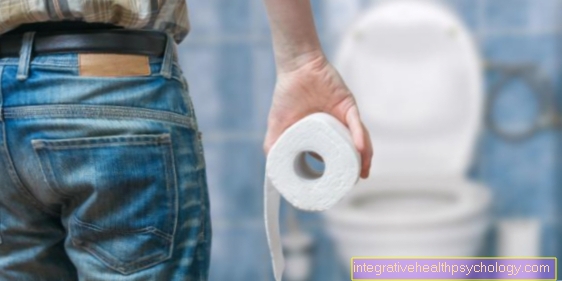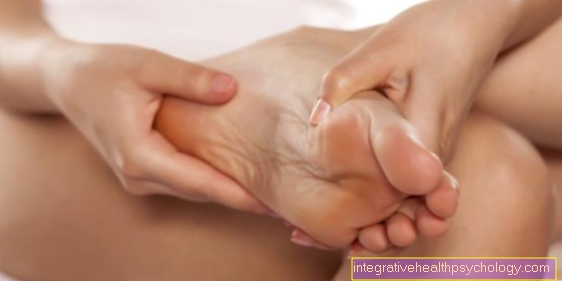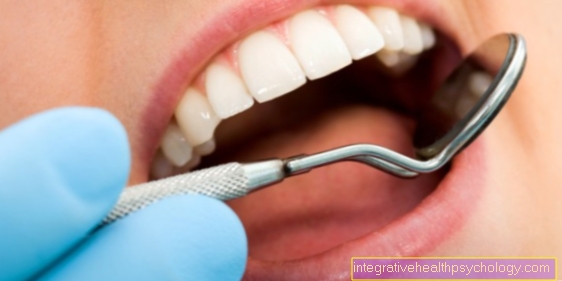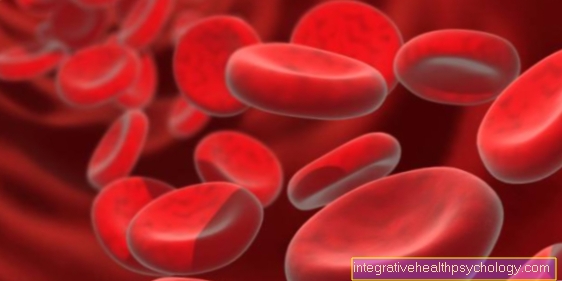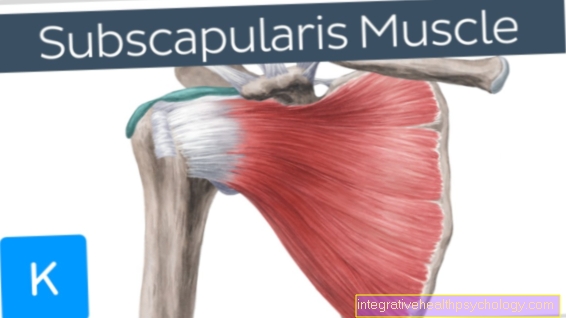Home remedies for earache
Overview - What home remedies are there?
Herbal remedies are only partially suitable for the independent treatment of earache. In addition, it must always be weighed up on a case-by-case basis which home remedy can be used sensibly. In any case, the unauthorized treatment with herbal remedies must not replace a medical examination. The symptom "earache" can be present in a wide range of diseases. A doctor should always assess the cause of the pain and whether all structures in the ear are still intact. The principle is that no liquid should be introduced into the ear. The risk is simply too great that fluid will enter the middle ear through a damaged eardrum. The effect can range from inflammation to damage to the ossicles.

Only pads in the form of onion or potato sachets can be placed on the outer ear. Only cotton wool should be placed directly into the external ear canal. In this context, careful attention should always be paid to an optimal fit and a loose seal of the ear canal. Anti-inflammatory and decongestant home remedies should also be preferred for ear pain. Garlic and onions with their antibacterial effect and saline solution with its decongestant effect can be used to support healing. However, they do not offer an optimal elimination of the cause and do not protect against the recurrence of earache. Infamous home remedies like olive or tea tree oil should even be avoided due to their allergenic potential and oily consistency.
Read more on the topic: Home remedies for otitis media
olive oil
From a medical point of view, the application of olive oil not recommended in the ear. Every vegetable oil contains ingredients that can lead to an allergic reaction. The effect would be a worsening of symptoms with increasing earache. In contrast to other herbal home remedies such as onions or garlic, olive oil has almost no disinfecting effect. The application does not promise any anti-inflammatory effects. The only way to use olive oil to treat earache is to dry the skin behind the ear. Dry, flaky skin can regain its elasticity and suppleness with the help of oil. The fat particles protect against further drying out of the skin because they can easily seal the top layer of skin. This makes it difficult for pathogens to penetrate a damaged skin barrier. All other causes of earache should be treated with medication or supportive herbal remedies.
Onion, onion juice and onion sachets
Onions have long been known as home remedies for earache. It is the essential oils of the onion that have an antibacterial effect and can lead to pain relief in the case of a pathogen-related otitis media. The juice of an onion in particular contains many ingredients Alliineto which the effect of a natural antibiotic is ascribed. In order to have the best effect of the onion on the ear, it is recommended to make an onion bag. Loose small pieces do not threaten to directly irritate the eardrum or even get into the middle ear through a torn eardrum. If you cut a raw onion into small pieces and wrap them in a thin cloth, the onions only have to be pressed a little with your hands. If the cloth is slightly soaked in onion juice as a result, the sachet filled with onion pieces can be placed on the outer ear. However, there is no guarantee of success for use with onion sachets. In individual cases, the onion can even lead to unpleasant itching in the ear canal, as its essential oils can also irritate the skin. If there is any uncomfortable feeling, the treatment should therefore be discontinued and better replaced by an internal application.
Internal use means drinking a homemade onion syrup using the onion as an example. Chopped onions are warmed up slightly and then mixed with a little sugar. The brownish syrup that emerges after a day can then be drunk mixed with a little water. This prevents unpleasant side effects on the skin or burning tears in the eyes. The ingredients of the onion, which are valuable for healing, are also absorbed through the mucous membrane of the gastrointestinal tract. However, undesirable side effects with this method are the unconventional taste of the syrup and possibly developing flatulence.
Cotton wool
Cotton wool is very good for relieving earache if the cause is the eardrum is badly inflamed or torn. The cotton wool seals the ear canal and thus protects the ear against the ingress of foreign objects such as dust. Dust particles would cause an additional inflammatory stimulus that could delay wound healing. In addition, the cotton wool also protects against loud noises that would stress the eardrum during the hearing process. In the case of an inflamed or injured eardrum, this would lead to pain, as the tension in the eardrum would irritate other nerves or even pull the edges of the wound. The cotton wool is a simple means that the ear can support in wound healing even without the addition of drugs.
If you also use ear drops or ointments on the prescription of a doctor, the cotton wool can take on two additional functions. On the one hand, it can prevent the ear drops from running out. On the other hand, it ensures that the active ingredients also reach their site of action and can be gradually released to the skin lining the ear cavity. However, this only works optimally if the wadding does not press against the surrounding structures, but just rests loosely. This is the only way to ensure adequate blood flow. In addition, care should be taken that the cotton is only pushed forward as far as it can safely be removed again. If the person concerned can remove the cotton wool with their bare fingers, this is a good indication of the correct position of the cotton wool. It lies in the external auditory canal and does not threaten to irritate the ossicles or nerves deep in the middle ear.
potato
Potatoes have a soothing effect on earache, primarily through a pleasant heat emission. However, in order not to burn the ear from boiled potatoes, it is advisable to place potato sachets on the ear. A boiled potato is mashed with a fork and wrapped in a thin cloth. If a pleasant temperature can be felt through the cloth, the potato sachet can be placed on the outer ear. The pain relief brings both the warmth itself and lying quietly on your side to hang up. The healing effect is due to the improved blood circulation due to the warmth.If the temperature in the ear canal rises, blood vessels expand reflexively and more blood flows through the structures in the ear. Urgently needed defense cells reach inflamed structures such as the eardrum with the blood. This allows the body to better control the infection. The subsequent wound healing also takes place faster, as the required substances can be transported to their destination more quickly. The potato itself does not have an antibacterial or disinfectant effect, but achieves symptom relief through its heat release. In addition, it supports the body's own wound healing without directly affecting the cause of the disease. If there is a bacterial infection of the ear, the application of heat to the ear should be viewed critically. The increased temperature in the ear offers optimal growth conditions for bacteria. A otitis media caused by bacteria is therefore not suitable for the use of potato sachets.
salt
Salt is often used in the form of saline to treat colds. Especially nasal irrigation leads to improved nasal breathing in the case of a cold, as it leads to the swelling of the mucous membranes. Swollen mucous membranes contain a lot of fluid that the salt can remove. Gargling a solution with table salt can also be used to relieve earache. When you gargle, the mucous membrane of the throat is moistened with salt water. The swelling of the pharynx then enables better ventilation of the middle ear, as both structures are connected to one another in the form of the Eustachian tube. With a cold, the Eustachian tube is often swollen shut as part of the inflammatory process. When the inflammation subsides, the connection structure is reopened and the pressure in the middle ear decreases. The eardrum relaxes and the earache subsides as a result. The direct application of salt in the ear should be avoided. If the eardrum is torn, for example as part of an otitis media, the fluid would flow into the ear unprotected. The result would be an accumulation of fluid in the middle ear, which cannot drain into the throat because of the swollen Eustachian tube. A humid chamber is formed, which is an ideal breeding ground for bacteria. The earache would therefore only worsen. For this reason, salt water should only be used in the form of nasal showers or gargles for the supportive treatment of ear pain. In these applications, the drainage of the liquid is guaranteed and has been proven to cause the inflamed mucous membranes to swell.
Tea tree oil
In the past, tea tree oil was often used to treat earache. Nowadays, however, there are numerous alternatives that are a better option. The danger with the use of tea tree oil is a strong irritation of the external auditory canal due to the various essential oils. Sensitive skin in particular reacts very strongly in the area of the ear to the herbal ingredients with burning and itching. There is also the risk that tea tree oil will get into the middle ear if the eardrum is torn. An allergic reaction can impair the ossicles. Mild, plant-based varieties such as garlic or potatoes should be preferred because of their lower side effect profile.
Read more on the topic: Tea tree oil
garlic
Garlic is a bulbous plant and its disinfecting effect can reduce the intensity of earache. For practical use, this means positioning a piece of garlic in the external auditory canal so that the essential oils can get to their site of action. From a medical point of view, it is recommended to squeeze garlic juice onto a piece of cotton wool and insert it into the ear canal. This eliminates the risk of the piece of garlic slipping too deep into the ear. The advantage of using garlic is that it has practically no side effects when used correctly. Only the smell can be perceived as annoying.
Camomile tea
Chamomile tea can be used as an aid to relieve earache. However, it should only be drunk and not used locally on the ear. Any liquid that gets into the ear can cause an allergic reaction. In chamomile tea, it is mainly the components of the flowers that can cause irritation. The effect would be to make the earache worse. However, when chamomile tea is drunk, the body only absorbs the ingredients through the gastrointestinal tract that it can use to support healing.
red light
Red light is often used to treat earache in children. The effect of the red light lamp is to generate a pleasant warmth, which leads to better blood circulation in the ear. The immune cells transported in the blood thus reach their destination faster. It is important to use red light treatment only in doses. Otherwise, it can worsen the symptoms. If the heat is too high, the enzymes required for wound healing cannot develop their effect. If the application of heat is excessive, there is even a risk of burns. A ten-minute treatment at a distance of fifty centimeters is therefore optimal to stimulate the blood circulation and not to disturb the function of the enzymes.
More information on home remedies for earache:
- Home remedies for stomach pain
- Home remedies for otitis media
- How can you safely remove earwax?
You can find an overview of other topics in ear, nose and throat medicine at: ENT A-Z














